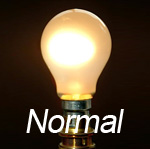The Dangers of LASIK: Thinking Twice About Laser Eye Surgery?
Are the dangers of LASIK really worth getting your knickers in a twist? With the recent admission by a former FDA chief that LASIK may be more dangerous than originally thought, it seems prudent to review the facts and figures. This article aims to cover all the common side effects and serious risks of laser eye surgery, as well as the latest admissions about the FDA clinical studies.
The Common Side Effects of LASIK
Studies show that 3% of LASIK patients report the following side effects of laser eye surgery, both on a temporary and permanent basis:
- Starbursts, Night Glare and Halos – When the pupils dilate in the dark, peripheral light rays are scattered more before they reach the retina, causing light sources to blur. It’s worse if the pupil dilates beyond the treatment zone in the center of the cornea. Many cases clear up after 3-6 months, but permanent starbursts, glare and halos must be corrected with prescription glasses or eye drops to reduce the size of the pupil at night.
 |
 |
 |
- Dry Eye Syndrome – This manifests as redness, itchiness, blurry vision, crusting, and feeling like you have something in your eye. This is very common but usually subsides within three months after surgery.
- Light Sensitivity – This is one of the most common side effects of LASIK. The temptation is to rub your eye when this happens, but this can actually impede the healing process or damage your eyes permanently during the LASIK recovery process. Most people find this side effect disappears.
- Visual Regression – During recovery from LASIK (which lasts several months) patients can have wrinkles and folds in the corneal flap which will actually make your eyesight worse to begin with. Certain people are more prone to visual regression, such as women taking hormone therapy.
The Dangers of LASIK: Serious Risks
Most people simply don’t understand probabilities. This is why every week, millions of people play the lottery even though their odds of winning the jackpot are abysmal. To make a point about the real risks of LASIK, let’s play the numbers game a bit more. In order of probability, you have a…
- 1 in 13,980,000 chance of winning the lottery jackpot
- 1 in 2,000,000 chance of being struck by lightning
- 1 in 705,000 chance of giving birth to quadruplets
- 1 in 12,000 chance of finding a pearl in an oyster
- 1 in 6,000 chance of dying in a car crash
- 1 in 500 chance of dying of cancer
- 1 in 33 chance of having side effects after LASIK
So, the probability of suffering side effects of LASIK are actually quite high. But just how serious are those side effects? The common side effects were listed above, for which you have a 1 in 33 chance of experiencing. However, you still have a 1 in 100 chance of suffering from serious dangers of LASIK, such as:
- Undercorrection – During laser eye surgery, the doctor will apply a specific amount of laser energy to obtain a precise result. Everybody reacts differently to the laser, and if you have serious nearsightedness, farsightedness or astigmatism (in this example, 9.00 diopters of correction) you have a 12-15% chance of being undercorrected and needing a second round of LASIK surgery at a later date. Patients needing a correction of just 3.00 diopters face a 2% chance of needing repeat surgery.
- Overcorrection – Likewise, a LASIK surgeon can accidentally overcorrect your vision. So if you are farsighted you may actually become temporarily nearsighted – and vice versa. This is treated with contacts or glasses until the eye naturally corrects itself. However, some cases of overcorrection are permanent, and require a secondary treatment 3-6 months later which carries even more risk of failure than the first surgery.
- Astigmatism – Occasionally, LASIK can cause astigmatism, resulting in blurry vision. You can choose to correct this by wearing glasses or contact lenses, or your surgeon may recommend follow-up LASIK to correct it.
- Haze – About 1% of people recover from procedures like PRK, LASEK and Epi LASIK with haze; a reaction in the cornea which can reduce the clarity of your vision. This is made worse by sunlight so you must protect your eyes from seriously damaging UV rays by wearing sunglasses in future.
- Corneal Abrasion – This is the breakdown of the cornea surface caused by the precision surgical knife which cuts open the corneal flap. It is usually treated with a contact lens “bandage” and heals quickly, though your vision will be very blurry for the next few days. Long term side effects are rare.
- Loss of Best Corrected Vision – Some patients (around 1%) lose visual clarity after LASIK, so that even with glasses you may still not be able to see the bottom 3 lines of the eye chart. This is due to irregular healing, although it can heal itself over the first year after laser eye surgery.
The Risks of Follow-Up LASIK
Follow-up LASIK is serious business. It is never the patient’s choice but rather a risk-weighted decision made by the surgeon. That’s because a second round of laser energy applied to the cornea carries further risk and should only be done as a true medical necessity – not just to see if you can make your vision a bit better.
This second dose is called an “enhancement procedure” but this implies your vision will be made better. In some cases, vision is made worse by follow-up laser eye surgery, often carrying more risk than the first round, such as epithelial ingrowth. Unfortunately, it’s still deemed necessary to give many patients multiple follow-up sessions of LASIK over the months and years after surgery.
Former FDA Official: “I Think We Screwed Up”
The dangers of LASIK do not end there. In May 2010, a scandal emerged involving the FDA (the government-run Food and Drug Administration) revealing that the true side effects of LASIK may be worse than anyone ever thought. That means the facts and figures above may be decidedly rose-tinted.
The LASIK procedure was officially deemed safe by the FDA in in 1998. But now, Morris Waxler, the former FDA Chief of Medical Devices (who oversaw the LASIK safety trials) is warning the public of the permanent damage that LASIK surgery yields to all of its patients. These risks include:
In an interview with ABC News, Morris Waxler said of the FDA’s LASIK approval: “I think we screwed up… Nobody’s going to admit that.”
And it’s not just Mr Waxler that is coming clean about the original safety trials. Another former FDA legal official, Larry Pilot, has stated his ongoing concerns that the FDA “is not actively investigating all questionable LASIK ASF’s (Ambulatory Surgical Facilities) for mandatory Medwatch compliance.”
Pilot is concerned about the FDA’s reporting system for patients with complaints about LASIK. The system is there so that the FDA can flag spikes in permanent consumer injuries to assess safety and efficacy. But without proper monitoring by the FDA – who is to say how safe LASIK really is?
Life After LASIK
Dean Kantis, the founder of the website Life After LASIK, is all too familiar with the true dangers of LASIK eye surgery. Kantis says: “there are absolutely no standards of care when it comes to LASIK, because the FDA continues to allow LASIK physicians to misstate Adverse Events (permanent injuries) as mere Temporary Side Effects.” His shocking find is that the publicized success rate of LASIK is 95.4% – when in reality it’s more like 75.4%.
“Remember, either the FDA Officials and ASCRS are downplaying the risks to the public that there are only about 140 LASIK cases filed in Medwatch, when the real worry that they have is if the hurt consumers realize that there should be about 3 million Medwatch LASIK cases filed. This would spark an epidemic involving outside offices to come in and investigate top FDA and ASCRS officials for possible criminal intent using a keratome blade and laser for assault and battery,” says Kantis.
What’s more, laser eye surgery is an elective procedure and there are known long-term damages to 100% of the eye corneas if you are open to hearing them. Why the FDA and ASCRS have not informed the public they swore to protect about these long terms risks, should worry every consumer in the world about their ability to oversee such studies without favoritism to private ophthalmologists.
Far from the reported rates of 1% of serious complications and 3% of mild side effects (1 in 33 cases), Dean Kantis has a much more chilling claim. “Would you go up in an airplane that crashed 1 out of 5 times? That’s about the safety and effectiveness of elective LASIK eye surgery!”
LASIK Alternatives
If you are concerned about the dangers of LASIK and laser eye surgery in general, don’t despair because there are other vision improvement options available. You do not need to go under the knife to correct your vision.
Fed up with blurry vision, itchy eyes and the stigma of wearing glasses all the time, I decided to take action and researched methods of natural vision improvement. All roads led me to eye exercises. So I began a reputable course – called Rebuild Your Vision – and set out on a daily routine of vision training.
In time eye exercises caused my prescription to reduce 2 diopters in each eye, so that I had about 20/40 vision and could go glasses-free.
According to Rebuild Your Vision, most vision disorders are caused by refractive errors, caused by bad vision habits and chronic eye strain. Eye exercises teach you to undo these habits and get your eyesight back into shape, so that you can see clearly without glasses. Learn more here.

